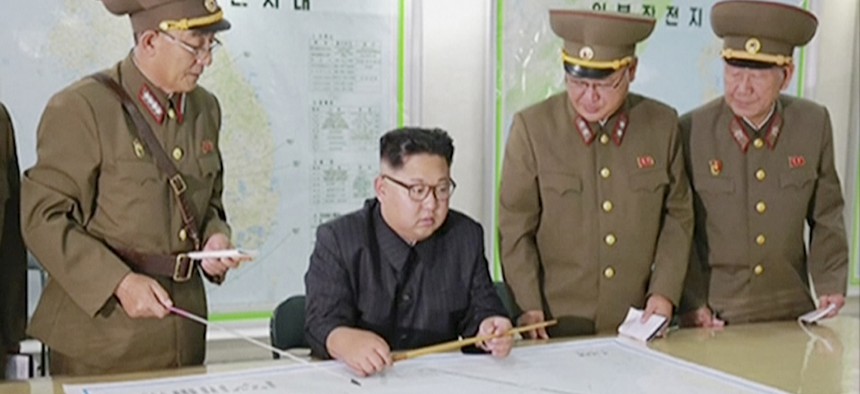
In this file image made from video of an Aug. 14, 2017, broadcast in a news bulletin by North Korea's KRT, North Korean leader Kim Jong Un receives a military briefing in Pyongyang. KRT via AP Video
Four Ways North Korea's Nukes Spell Trouble for the US — Even If They're Never Used
Kim Jong Un's ability to export anything from ICBM plans to working warheads gives him tremendous leverage, while boxing in U.S. responses.
Those who argue that North Korea’s new intercontinental nuclear capability can be managed with Cold War-style deterrence have too narrowly conceived the threat. The spectre of direct strikes notwithstanding, Pyongyang is likely to draw from a much wider nuclear playbook in attempting to improve its position vis-à-vis the United States.
One of the biggest risks is of horizontal proliferation: the risk that North Korea will export its growing pool of nuclear weapons technologies to other nuclear aspirants. The regime has a rich history of transferring nuclear and missile technologies; past recipients include Pakistan, Iran, Syria and others. Future transfers could be as low-key as emailing plans for bomb cores, missiles, or nuclear reactors to other states, or as involved as sending ready-to-use nuclear warheads and missiles through its network of sanctions-busting trade routes. That North Korea purportedly now has the ability to develop fully functional nuclear warheads no bigger than a beach ball should make observers nervous, particularly with CIA Director Mike Pompeo recently confirming that he could “absolutely not” ensure that U.S. intelligence agencies would uncover all such trades.
So what specific threats are posed by North Korean horizontal proliferation?
The first, and most obvious, is that it could spread nuclear capabilities to other states, particularly in the Middle East, East Asia, and South Asia. This would complicate U.S. efforts to stabilize these regions, and spread more thinly its non-proliferation efforts.
Second, it could undermine the global community’s economic pressure on Pyongyang. Trading in weapons of mass destruction is a profitable business. A.Q. Khan, the former front man of the Pakistani nuclear black market, reportedly amassed a personal wealth of hundreds of millions of dollars by trading his nuclear wares with a rogues’ gallery of despots and dictators. North Korea could use a similar stream of hard currency to dull the coercive effects of international sanctions, or to reinvest into the nuclear weapons program itself.
Third, by supplying such technologies to other nuclear aspirants, Pyongyang could build a community of interest that seeks to buck U.S. efforts at denuclearization and regime change in North Korea. The greater the number of states that rely on such North Korean exports, the greater the pool of collective political influence that will seek to undermine such U.S. efforts. They might, for example, oppose in diplomatic forums U.S. sanctions against Pyongyang; shift their superpower allegiance from the U.S. to China, the latter of which has a far more lenient posture toward the North Korean nuclear weapons program; or pressure the United States, through economic statecraft, to moderate its position on North Korea. This could be particularly problematic for the U.S. were the oil-producing states of the Middle East – for example Saudi Arabia and the UAE, both of which have been recognized as potential future North Korea nuclear collaborators – to come into a North Korean supply network. Could the U.S. pursue North Korean denuclearization so vigorously, or depend on the support from other states in this mission, were such efforts to jeopardize the flow of oil?
And fourth, North Korea could use the threat of horizontal proliferation as a tool of blackmail, threatening to export nuclear secrets and technology unless the U.S. agrees to some specified political or economic concession. And while Pyongyang’s usual threats of fire and fury lack credibility due to the U.S.’s vastly superior conventional and nuclear forces, its threats of nuclear transfers would be credible given the U.S.’s limited ability to punish such transgressions. At most, the U.S. could advocate for further sanctions on such provocations, though such measures would likely struggle to find wide support among the international community. Countries with an interest in spoiling sanctions against North Korea, principally China and Russia, could deflate the U.S. claims by labeling North Korean threats as empty bombast. Even where there is broad international support for sanctioning North Korea, it may behoove a risk-averse U.S. to simply make the concession. It’s hard to imagine what Washington wouldn’t forfeit to stop Pyongyang from handing a functional nuclear warhead over to Iran or Syria, for example.
So what are the U.S. options? As a first step, the Trump administration must open itself to negotiations with Pyongyang on the nuclear transfers issue (the upcoming dialogue in Singapore would be a good place to start). While North Korea is unlikely to ever entirely and voluntarily give up its nuclear weapons, it will be more willing to negotiate on the margins of its capabilities, such as in providing assurances to the U.S. that it won’t transfer sensitive technologies to third parties. Of course, a despot is only as good as his word, and thus the U.S. will also need to take unilateral measures to undercut both Pyongyang’s ability to trade in sensitive nuclear technologies, as well as the market for its wares. The U.S. should strengthen the existing infrastructure around monitoring and interdicting illicit North Korean exports such as through the National Nuclear Security Administration.
Secondly, the U.S. should strengthen the international regulatory framework around horizontal transfers of nuclear and missile technologies such that there is broad international buy-in to punish North Korean threats and acts of exporting illicit technologies.
And thirdly, the U.S. should seek to improve relations with those states likely to be drawn into a North Korean supplier network. As these states enjoy the benefits of better relations with the U.S., they will have more to lose in spurning Washington by engaging in nuclear and missile cooperation with Pyongyang.




